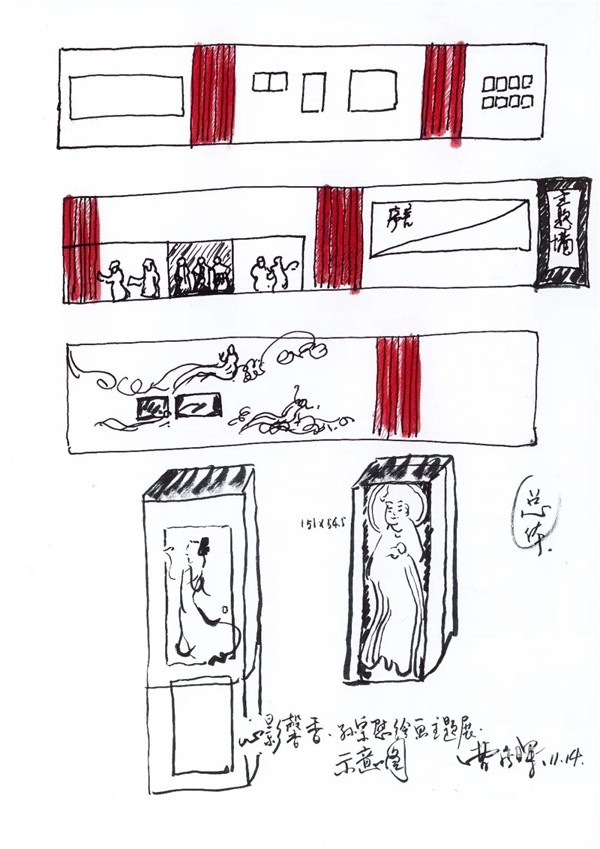
2022年是曾任中央美术学院绘画系副教授的画家孙宗慰诞辰110周年,为纪念和研究他在中国现代绘画实践上的贡献,中央美术学院党委宣传部将为之举办纪念展的计划列入“百年辉煌——中央美术学院艺术名家”中,于2022年1月在美术馆正式启动了展览筹备工作。此后,担任展览策展人的中央美术学院人文学院美术史系教授曹庆晖,在了解孙宗慰作品材料和已有研究与出版的基础上,与团队成员随时线上交流研讨,逐步明确了展览的主题、逻辑、结构和作品,形成名为“心影馨香——孙宗慰绘画主题展”的展览方案,2023年2月策展方案通过学院汇报,3月1日在中央美术学院美术馆落地开幕。
这里,旨在通过对多次策展会议纪要的编辑,结合不断深入的策展构思稿、设计效果图和现场实景图的有序排列,向观众呈现展览从无到有、作品从选入到安放的大致过程,希望在为观众莅临现场参观展览提供导引服务的同时,也能了解策展与实施等展览背后的一些思考,实际上为大家提供一份漫步展览的学术导航。但必须声明,导航在这里的意义主要是交代和交流,是可以被批评也欢迎被批评的一家之言。
祝大家阳春三月在中央美术学院美术馆观展愉快!

考虑到过往展览和研究对孙宗慰绘画艺术的发现和梳理已有基本的呈现,因此如何开辟学术话题就成为展览策划首先要面对的问题,最终我倾向以画家的“绘画性”实践为主要关心,试图回到画家之眼,看他在所看中如何通过绘画的逻辑和方法表达他对社会和自己的理解。
孙宗慰是徐悲鸿等人在1934—1938年的国立中央大学培养起来的画家。徐悲鸿重视写生造化,他在教学上的基本训练方法是中介法国学院素描要求产生的绘画“新七法”,其中的要旨是通过实像模写领会绘画的写实性要义,这也是孙宗慰接受绘画训练吃的开口奶。孙宗慰在1941—1942年曾协助张大千在敦煌、塔尔寺等地进行过壁画临摹和画稿整理,1953年又参加中央文化部社会事业管理局组织的麦积山勘察团壁画临摹。这些描绘在石窟里的壁画创造的是信仰世界,虽然世人谁也没真正经见过那样的世界,但它却可以通过工匠结合生活经验、教义教条和绘画想象获得,心象图绘,粉本绵延,亦真亦幻,在我看来即其逻辑、方法和效果。但这并不止于石窟壁画,唐宋以后文人画大行其道,心象图绘历元明清文人加持和演进,被建构成以笔墨为形式和精神表征的图绘性绘画语言体系,孙宗慰通过张大千的绘画并上溯石涛、老莲等人,所玩味的就是这一体系中的图绘性营养。孙宗慰的绘画性实践就交织在这种中介法国画学的写实性和源于中国画学的图绘性的融变和创生中,并且我认为他的绘画性实践是中国绘画现代性实践中足堪观察和研究的一例。“心影馨香——孙宗慰绘画主题展”的英文译题明确了展览意图集中的绘画性话题,Modernity in Sun Zongwei's Practice of Painting.

《西北写生之头像(一)》,孙宗慰,纸本素描,48.5×35.5cm,1942年,家属提供

《敦煌壁画之飞天》,孙宗慰,纸本彩墨,30×69cm,1945年,家属提供

《蒙藏女子歌舞》,孙宗慰,布面油画,90×120cm,1943年,中央美术学院美术馆藏
主题展分三章。第一章“天地霓裳——边地佛国的丽影姿色”,以孙宗慰在西北临摹和创作的作品为主。第二章“江水东流——长河行旅的移步换景”,主要是孙宗慰从四川到北京的重要作品的排列组合。最后一章“馨香无尽——梦寐以求的平川牡丹”,基本是孙宗慰的自画像、花卉、静物以及临摹。如此三章,论全不及全面展示孙宗慰一生成绩的面向周全,说详不如专题展览孙宗慰人生特定时期的作品周详,但均着重于画家之眼及其视觉逻辑,呈现孙宗慰绘画性实践的根源特质和逻辑发展。

展厅墙面标注示意设计稿
展览使用的是中央美术学院美术馆2层B展厅,该展厅常用于举办名家大师的展览。在这里举办孙宗慰的展览,对我而言,好处是熟悉,挑战是要在熟悉的空间里创造符合主题的视觉体验,形成展览独有的空间调性,不容易。最终的设想是选择三种视觉元素规划展厅。首先是“线描装饰”,既然是讨论“绘画性”的问题,那么展览的绘画气氛和气质就不能低,但怎么搞呢?从孙宗慰的临摹和写生线稿中选取图像作为装饰,通过丝网印刷描绘在动线“起承转合”处,是能够想到和实现的一个办法。其次是“垂缦区隔”,就是利用垂缦这种软性材料对展线上的作品进行强调或进行分组,垂缦的形式与颜色受孙宗慰笔下僧人和民族妇女服饰与色彩的视觉启发较多,软材料,强介入,容易形成有力的空间布控并在熟悉的展厅制造陌生感。动线上则采用“立柱模拟”的方式,在展厅中模拟搭建石窟立柱,除了虚拟石窟情境的意图外,主要目的是打破固有的动线和空间,避免参观时的一眼到底,一览无余。

“心影馨香”策展手绘稿,此图呈现对视觉元素的设想

展厅入口圆弧墙的策展手绘稿

展厅入口圆弧墙的墙面设计稿

展厅入口圆弧墙实景
与弧面墙垂直的长墙是二层B展厅的主墙,是真正可以悬挂作品的墙面,由入口拾梯而上所见的是这面墙的正面,在这次展览中我们称之为3号墙,展览的第一章“天地霓裳——边地佛国的丽影姿色”由此开始。这个标题,纯然是从视觉上理解孙宗慰西北临摹与写生后的选择,因为在孙宗慰笔下无论是天上还是人间,是线描还是油彩,总体上都呈现出如题的视觉感受。
墙面上主要集中呈现孙宗慰围绕少数民族服饰和蒙藏人物绘制的一系列作品。开篇是《哈萨克妇人》,画中人描绘偏于写实,向左而立,正是展览和动线的起点。之后两组共16张少数民族人物,进行了先正面再背面形象的分组组合,明确向观众展示孙宗慰处理民族人物采取的两面观视角,16张并排而立后由《哈萨克人歌舞图》压阵,预示在相对单纯的人物正背面描绘之后将逐渐进入孙宗慰对西北风物风俗的描绘。展墙下方另有两套册页放置展柜内,册页内的人物与墙面作品不仅呼应,而且存在对同一形象反复描绘的特点,这种特点在后面的展品中依旧持续不断。同一形象反复绘制并非机械复制,而是绘画性生长的反映,能够一画再画不断言说,说明孙宗慰力图在特殊中归集一般。所以3号墙上的大多数作品,在我们看来有些像孙宗慰绘画艺术的词根表一样。通过这些人物词根,我们可以看到一种民族或身份的人的存在,同时也能感到他不是在描绘具体哪一个人,而是在形象的加减乘除中形成具有符号意义的形象,一种图绘性较强的形象。形象成为一般性的符号编码才能被不断挪用组装和再生产,形象不能被编码就永远定格在写生的或构图的具体规定性中,既难以重复,也难以融入图式。在特殊性中归集普遍性,这种创作特色一直延续在孙宗慰的作品里。当然,他的自画像和委托肖像另当别论。

3号墙的策展手绘稿

3号墙的墙面设计稿

3号墙实景
3号墙和5号墙之间是一根立柱,展览策划标为4号立柱,立柱上是和3号墙题材相关的三张蒙藏人物油画和一组类似服饰调查笔记的速写。此组服饰速写包括帽、上衣、围裙与靴子,材质为简单的铅笔与水彩,其目的是掌握民族服饰的质地与做工,这种基于实用性的观察和描绘后来也演变为孙宗慰绘画的一种表现方式。负水的喇嘛真是一张好画,我们很希望观众在入口眺望时就能看到。这张画的人物和环境的把握,显然得益于孙宗慰随徐悲鸿的学习,但袈裟里的躯干和外露的双手明显不是按照解剖而来,而是根据袈裟裹身一褶一褶的扭麻花一样排叠的需要配合而来。所以,与其说他穿的是一身复杂的袈裟,不如说他穿的是一身堆叠的图案。
《负水者》,孙宗慰,布面油画,47×29cm,1942年,家属提供
《靴子颜色及装饰图案示意图》,孙宗慰,纸本铅笔水彩,20.4×31.7cm,1942年,泰康保险集团收藏
5号墙是呈现夹角的墙面,从3号墙经过4号立柱走过来,我希望在民族人物的彩墨与油绘之后展现敦煌风光和壁画意象,于是选择了孙宗慰临摹的飞天图像进行拆分后刻印上墙,营造天女祥云飘飘落落的景象。在下界先有一张挂的很低以凸显仰望天边的民族姑娘的背影,让她承担视觉上承前启后的职能。此后接排若干风景,天女之下正是孙宗慰的油画代表作《月牙泉》。
4、5号墙的策展手绘稿
5号墙的墙面设计稿
3、4和5号墙区域实景
5号墙实景
进入6号墙,靠近前厅一侧是两张很大的线描稿《敦煌壁画之普贤变》《敦煌壁画之文殊变》。立在4号立柱附近,观看5号和6号展墙,视觉上正是由边地到佛国,人间到天界的景观变化。孙宗慰眼里的敦煌,就在眼前!走到这里的每位观众,其实都早已听到安装在4号柱的歌曲和音乐,那是西北的花儿《上去高山望平川》。歌中唱到:“上去高山望平川,平川里有朵牡丹,看去容易摘去难,摘不到手里是枉然。”在展览立意上,我把平川牡丹比拟为绘画性。
6号墙的后半段全是蒙藏生活题材的中国画,3号墙上那些已经呈现出来的符号化的人物形象,在6号墙的作品中可以看到他们被不断组织为新构图的再利用事实,这种连续不断的形象构图在我们看来是孙宗慰绘画性逻辑的自觉延伸和反应,它与机械复制以满足市场需要是两个完全不同层面的问题。
《蒙藏生活图之牧羊》,孙宗慰,纸本彩墨,42×32cm,1940年代,中国美术馆藏
《牧羊》,孙宗慰,纸本彩墨,106.5×61.5cm,1940年代,家属提供
4、6号墙的策展手绘稿
4、6号墙的空间方案设计稿
3、4、6号墙区域实景
7号墙是3号墙的背面,雄踞主展厅一侧,是B展厅最为隆重的展区。这面墙特别在中心位置突出了中央美术学院美术馆收藏的孙宗慰油画代表作《蒙藏女子歌舞》,两侧悬挂了两道垂幔,以示隆重。垂幔的使用在展览中有时是出于装饰强调需要,有时是出于内容区隔需要,往往根据具体情况具体分析,并无一定,但我们也非常注意垂幔的数量与位置,尽可能使其在整体布局上符合丰富与平衡的视觉尺度关系。挂两道垂幔的作品,在这个展览上不仅7号墙有,6号墙和8号墙中孙宗慰的临摹大作也有。与中心作品相配合的,南侧一组《驼队》《塔尔寺小金瓦寺》《哈萨克人跳弦子》,在视觉上继续衔接了6号墙蒙藏风俗的内容,北侧一组靠近入口弧面墙的是蒙藏舞女的彩墨和线描作品,弧面墙上的藏女舞蹈形象即从这组作品中提取。由7号墙可以一览孙宗慰利用油画和中国画的不同媒介,对西北民族风俗生活翻来覆去不断创作的热情和兴趣。
7号墙的策展手绘稿
7号墙的墙面设计稿
7号墙实景
靠近弧面墙的8号墙和9号立柱是一组内容关联的作品,陈列的都是孙宗慰在1953年参加文化部社会事业管理局组织的麦积山勘察团临摹和写生的作品。这次临摹和20世纪40年代孙宗慰随张大千在敦煌临摹在方法上很不一样,偏于照相写实。其中8号墙的摹品尺寸巨大,为中央美术学院美术馆藏。10、11和12号立柱,集中陈列的是孙宗慰20世纪40年代临摹的敦煌壁画以及以此为素材的创稿,同时也兼顾了他当时在西北对人物动物的素描写生。我在展厅现场对这些立柱的位置和角度进行过充分的考虑和调整。壁画临摹和素描习作集中在立柱上,一方面是让它们区别于墙面上的孙宗慰画作,一方面是形成类似于石窟中心柱的景观意象,这为作品悬挂提供了足够进行自由和高低组合的平面,更重要的作用是通过立柱打破主展厅一览无余的空间格局,在立柱和立柱之间制造出观览的空隙,形成不一样的体验和感受。
9号立柱的策展手绘稿
9号立柱实景
10、11、12号立柱实景
与7号墙形成对视关系的是13号墙,也是第二章“江水东流——长河行旅的移步换景”的开篇。13—17号墙均属于第二章的内容,动线延续一直到精品厅外。过往有关孙宗慰的展览较多从艺术社会学去观察画家的变化,强调旧社会与新中国的时代变革带来画家的题材和思想之变,此次展览移步换景的思路,重点观察孙宗慰在人生行旅中所经历的不同时代景观中持续稳定的绘画性实践。
对13号墙面上的一组四川风景作品,我在现场进行了比较大的创作型重置,不同的风景画依照壁画底图上下高低的错落起来,让整面墙形成一幅更加弘大的四川风景图,其活泼与对视的7号墙的中正相对相生,一起构建了整个展厅既中正又活泼的调性。
四川风景图之后是一组由人物画和风景画结构起来的北平风景图,与四川风景图相呼应,北平风景图的作品摆放也注意高低节奏,意图希望通过这种节奏变化应合江水东流、移步换景的策展逻辑。我很愿意在方方面面尝试打破循规蹈矩,尽量使得每一展段的空间叙事与作品组织以及内涵呈现发生有效的呼应关系。北平风景图中的两张水墨人物大画《灯红酒绿》《打粥》由上海龙美术馆提供,此次展览的顺利举办得到龙美术馆的积极响应和支持,悉数提供了展览需要的孙宗慰代表作。在此特别要向提供藏品的龙美术馆、中国美术馆、泰康保险集团、势象艺术中心以及多位私人藏家表示感谢。
从《灯红酒绿》《打粥》到15号墙上的《运粮》《运煤》和《迎接和平解放》是孙宗慰的一组反应北平民生的水墨人物代表作。比较西北少数民族人物系列,孙宗慰绘画性实践的延伸和发展更多地反应为构图以及组成构图的人物及其道具的写实概括性在加强和丰富。因为写实性,观众可以从画面内容感受到画家朴素的悲天悯人的良心和态度,因为概括性,观众可以从入画物象看到画家对人物角色和道具细节的丰富表现,而这种丰富表现更多地反映为孙宗慰用线用墨用色把握物象的图绘性语言在丰富。
13号墙的策展手绘稿
14号墙的策展手绘稿
15号墙的策展手绘稿
13号墙的墙面设计稿
13号墙实景
从16号墙的《女车工》开始,到延展较长的17号弧面墙,展览进入孙宗慰对新中国图景创造的展示。实际上,展览在空间调度上为预示在新旧社会间移步换景的视觉逻辑,已经在远离16号墙的区域给出了提示。这就是在15号墙的位置抬头向前看过去,会看到一艘船,一艘具有工业化特点的船迎面而来。这艘船的图像出自孙宗慰的画稿,描绘的是塘沽新港的挖泥船。
沿着这艘船的方向前行是17号墙。17号墙的策展处理和13号墙有一致的逻辑,即把墙面作画面,安放作品“画”起来。13号墙用孙宗慰数幅油画风景组装了四川风景图,17号墙则主要用孙宗慰塘沽新港线描稿中的挖泥船、造船工人为墙面底图设计的元素,以《石景山钢铁厂》《塘沽新港》两组作品为重点,沿动线组装成一幅建设图。其中,《塘沽新港》一组尤其值得关注。画家为了反映新中国建设成就,曾在1953年底1954年初的寒冬季节独自前往塘沽新港写生一个月,展出的以线描、彩墨和油画为媒介创作的塘沽新港码头和造船厂,即为这一个月写生后在北京整理所得画稿。线稿和彩墨长度都在两米以上。从中可见,孙宗慰以一种别具一格的方式创造了他经见的塘沽新港图景。这种别具一格——以写生为基础的以大观小的形象与图式处理——正是孙宗慰绘画性生长的反应。
从主展厅看向17号墙的策展手绘稿
从主展厅看向17号墙的实景
17号墙的策展手绘稿
17号墙的墙面设计稿
17号墙实景
18、19号墙的策展手绘稿
18、19号墙的墙面设计稿
18、19号墙实景
精品厅,在这次策展中被编为20号,共展出孙宗慰13件自画像以及不同时期的若干小照片,也属于第三章的内容。目前所知孙宗慰在1949年后基本没有再画自画像。自画像是欧洲艺术史的传统,也为孙宗慰的老师徐悲鸿所提倡。孙宗慰在现实生活中沉默寡言,甚至给人以木讷的印象,但在自画像的世界里,他的面目并不单一,被公认的那件最具有代表性的自画像《塞上行》,充满自信,像个王,被以背衬垂幔的方式特别隆重地陈列起来。在它左侧的一系列自画像因大体有一个相近的画室逻辑而被排列一侧,在它右侧的自画像系列则基本以吸烟为肖像的取姿。因为自画像系列最充分地回应了展览所关注的绘画性中写实性那一面的知识和逻辑,因此其他重复回应该问题的作品均不再纳入览。
《塞上行》,孙宗慰,布面油画,78×67cm,1947年,家属提供
《画室里》,孙宗慰,布面油画,66×52cm,1945年,家属提
《自画像》,孙宗慰,木板油画,直径45cm,1940年代,中央美术学院美术馆藏
精品厅实景
21号立柱和22、23、24号墙呈现的是孙宗慰的静物油画和花卉彩墨作品,也都是第三章的内容,这些作品的汇集,令我们对孙宗慰在花卉果蔬题材里,比较自如且极具水准和品质地在中西之间来回切换印象深刻,写实不匠气,图绘有朝气。
21号立柱和22、23、24号墙区域实景
25号墙有一篇展览说明,特别印制了展厅平面图和策展手绘稿的位置关系,不嫌烦的观众通过这张图能对展览的整体布局有一个大致把握。25号墙和26号墙在我们看来是一个整体,都是展览的尾声,为了在最后表示对孙宗慰先生的缅怀以及对展览主题心影馨香和绘画性的关心,我们专门挑选了一件孙宗慰没有画完但很有意境的白描荷花作为收笔和告别,墙面上依旧采用了敦煌飞天的图像元素作为装饰图案。21号立柱播放的是根据青海花儿《白莲花》改编的协奏曲,原本是想让观众走到26号墙附近再环绕起来,但因实在找不到合适的掩藏音源的位置,不得已将音源位置提前了二十多米,这个做法虽不是最理想,但也能接受,因为这首曲子和21号周围的作品环境并不违和。对于画家纪念性展览而言,要不要配乐,怎么配乐,说不好,具体情况具体分析具体感觉着来吧,凡事无一定,一定事必烦。这次我们用了配乐,主要是青海花儿《上去高山望平川》《白莲花》和我们的展览内容、逻辑和调性相关,既便于情境导入,也有利于启发怀想,何乐而不为呢?
25号墙的策展手绘稿
25号墙实景
26号墙的策展手绘稿
26号墙的墙面设计稿
26号墙实景
本次展览印制了小册子供观众领取,小册子收录了“前言”“说明”和展品目录,作为对此次展览内容的记录。
策展手绘图由策展人曹庆晖教授提供
策展团队成员包括易玥、孙丹妮
设计稿由纪玉洁、闵志伊
刘宇晗、李晋羽提供
心影馨香——孙宗慰绘画主题展
主 办:中央美术学院
承 办:
中央美术学院党委宣传部
中央美术学院美术馆
中央美术学院油画系
展览时间:2023年2月28日—3月26日
展览地点:中央美术学院美术馆二层B展厅
总策划:高洪 范迪安
学术主持:邱志杰
项目策划:秦建平
策展人:曹庆晖
展览总监:张子康 韩文超
展览统筹:王春辰 高高
特别支持:孙景明 孙景年 许红
策展助理:易玥 孙丹妮
展览协调:赵晶 孙文 刘希言
设计总监:纪玉洁
